Located in southwestern Africa, Namibia boasts a well-developed infrastructure, some of the best tourist facilities in Africa, and an impressive list of breathtaking natural wonders. Visitors can explore the capital of Windhoek and discover the lovely coastal town of Swakopmund boasting remnants of the country’s German influence, reflected in the architecture, culture, cuisine and the annual Oktoberfest celebrations. To properly appreciate this extraordinary country, you will have to venture out of the cities to explore the remarkable natural landscapes Namibia has to offer. These include: the impressive Fish River Canyon; the vast Etosha National Park teeming with abundant wildlife, such as lions, desert-adapted elephants and the Hartmann's Mountain Zebra; the hauntingly beautiful Kalahari Desert; and of course the Namib Desert stretching for over 2000 km along the magnificent Atlantic Coast. Namibia is an ideal destination for travellers seeking an unforgettable African experience in a uniquely beautiful untamed wilderness.
Situated in Central Namibia, the cosmopolitan city of Windhoek serves as the capital of the country. It is home to an international airport and a plethora of restaurants, shops, entertainment venues and accommodation options. The city is clean, safe and well-organised, with a colonial legacy that is reflected in its many German eateries and shops, and the widespread use of the German language. Windhoek has an interesting mix of historical architecture and modern buildings, many of which are worth a look, including the Alte Feste an old fort, the 1896 Christuskirche Christ Church, and the more contemporary Supreme Court.
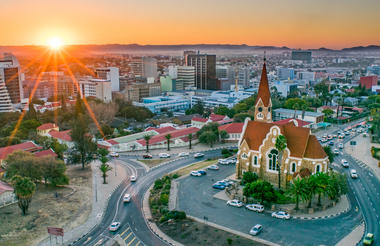
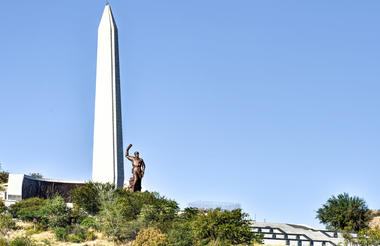
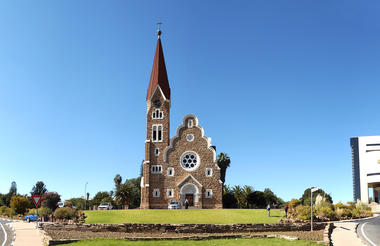
Situated in north central Namibia and named for the springs that emanate from its foothills, the Waterberg Plateau National Park is a fascinating geological site featuring compressed sandstone crags, 200 million-year-old dinosaur footprints, and petrified sand dunes. The area’s natural water sources make it far more fertile than its environs, and the park is blessed with a plethora of plant and animal species, including leopards, rhinoceros, vultures, cheetahs, bush babies, ferns and fig trees. Visitors can enjoy a wide selection of activities including: learning about the local Herero culture on an informative village tour, tracking rhino on a guided safari, exploring the Waterberg's 50-kilometre-long and 16-kilometre-wide sandstone plateau, dubbed 'table mountain', and catching a glimpse of the rare and endangered sable and roan antelope.
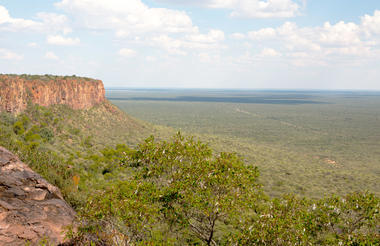


Grashoek is a wonderful little rural town set about halfway between Grootfontein and Tsumkwe in northwestern Namibia. Remote, wild and beautiful, it offers spectacular hiking and nature photography opportunities. The town is best known as the home of the fascinating Living Museum, an authentic open-air museum celebrating the culture of the local Ju'Hoasani people, who have been living off the land for hundreds of years. Actors guide guests through customs and ways of life. Visitors can look forward to a range of interactive activities such as learning to shoot an arrow or singing a traditional song. The enthralling Mangetti Park is nearby.



Set along the southwestern banks of the Okavango River, Bagani is a small town within Namibia's Kavango East Region. This hidden gem holds historical significance as the homestead of the Mbukushu kings, one of the five kingdoms of the Kavango people. Outdoor enthusiasts will find Bagani a haven for adventure. Anglers can cast their lines for tigerfish and catfish in the Okavango's abundant waters. Birdwatchers will be delighted by the region's diverse avian life, with over 400 species recorded. For those seeking wildlife encounters, nearby Popa Game Park boasts the impressive Popa Falls, a series of cascading rapids on the Okavango River. Mahango Game Park offers visitors the chance to spot elephants, buffalo, giraffes, and various antelope species, including the rare roan and sable antelope. Its floodplains and wetlands are teeming with birdlife, making it a birder's paradise.



Meandering through the spectacular Caprivi Strip in northwest Namibia, the Kwando River rises from the central Angolan highlands forming the boundary between Namibia, Zambia and Angola. The area surrounding the Kwando River is known for its protected game reserves, national parks and wildlife sanctuaries. It offers excellent game viewing with the perennial waters of the river attracting plentiful wildlife including large herds of elephant, hippos, crocodiles, red lechwe, turtles, zebra, impala, spotted-necked otters and over 400 species of bird. Visitors can enjoy a relaxing stay at one of the many lodges set on the banks of the river and soak up the spectacular views of wild Africa. Popular activities include: game viewing, bird watching, fishing, and camping.

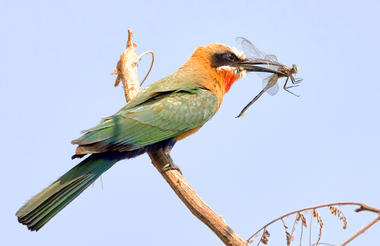

Forming the boundary between Botswana and Namibia is the Chobe River - one of the most well-known perennial rivers in Africa. The Chobe River Front encompasses vast floodplains fringed by lush riverine woodlands. The abundant wildlife inhabiting the river and its shores can be viewed from a river safari where visitors can spot elephants, hippo, water-loving antelope including the rare red lechwe and a variety of other game such as giraffe, zebra, and buffalo. Nature lovers will delight in the incredibly scenic natural landscapes and bird watchers can look forward to the wide section of bird species which can be spotted along the river banks.

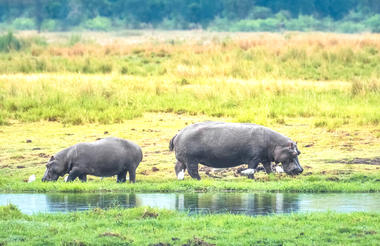
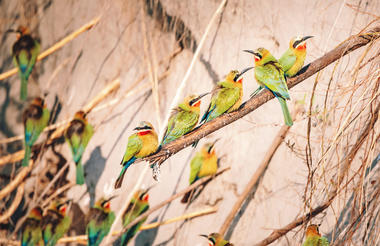
Situated in the southern reaches of Africa, Botswana is renowned for its pristine wilderness areas characterised by deep lagoons, wetlands, lush palms, rugged hills and desert plains. The country’s primary tourist drawcard is undoubtedly the vast red expanse of the Kalahari Desert and its remarkably beautiful Okavango Delta, the largest inland delta in the world. These natural wonders provide a tranquil haven for an abundance of African wildlife to thrive. Other highlights include the impressive Makgadikgadi Salt Pans, where visitors are privy to massive zebra migrations during the flood season; the Savuti plains, which host a significant pride of lions; and the Tsodilo Hills, where 4500 rock paintings form a unique record of human settlement over many millennia.
Situated 180 kilometres north of Francistown, the small village of Nata is a popular stopover between Maun and Kasane along the ‘game drive route’ (there is often a chance to catch a glimpse of wildlife along the way). The unique surrounding landscapes feature white sand, tall termite mounds, and Mokolwane palm trees. The Nata Sanctuary is a particular highlight for avid bird watchers, where lucky visitors can be rewarded with large flocks of Flamingos and Pelicans, which breed here each year. The town is also a perfect base for exploring the legendary and spectacular Makgadikgadi Pans, where quad biking and four-wheel-drive tours can be enjoyed.

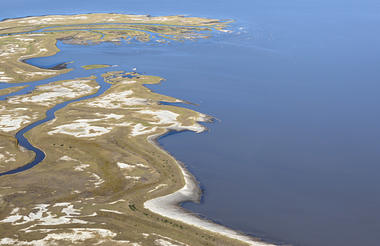
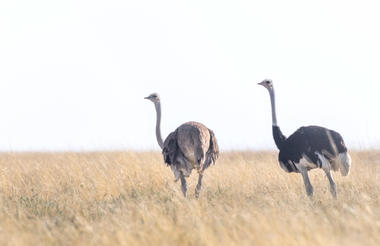
North-eastern Botwana’s Boteti River, within the Makgadikgadi Pans National Park, lies on the grounds of an ancient lake, within a region where some of the first ‘homo sapiens’ (humans) lived. This area is an essential part of the massive annual migration - visitors can look forward to seeing enormous herds of oryx, wildebeests, impalas, zebras, and springbok as well as elephants and hippopotamuses along the riverbank. The river also provides prime bird-watching opportunities, with large flocks of flamingos and numerous other species calling it home. Besides the usual nature reserve activities, try taking a small chartered plane for the best views of the herds; go quad biking across salt flats and sleep there under the stars, or take a cultural tour to see ancient tribal sites.

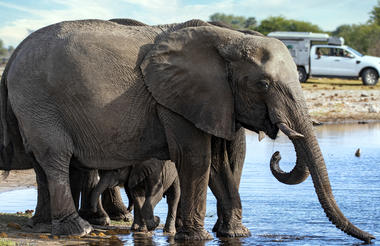
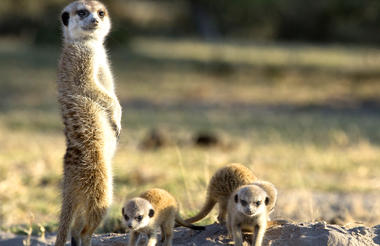
As previously described
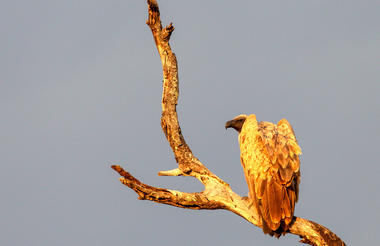

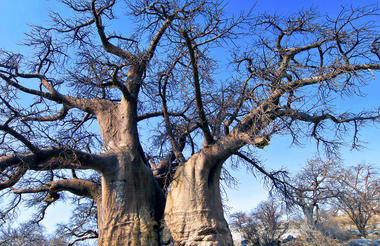
Set on the banks of the beautiful Thamalakane River in northern Botswana, Maun is the third-largest town in this spectacularly scenic southern African country. Maun is the starting point for most expeditions into the Okavango Delta and as a result, has developed into a bustling metropolis that is considered Botswana’s tourism capital. Area attractions include a renowned riverboat that offers cruises up and down the Thamalakane River; the forest groves of the Maun Game Reserve; and Moremi Game Reserve, home to hippos, lions and rhinos. Maun also serves as the jumping-off point for many safaris and air charters as well as offering private 4x4 rentals. Don’t miss the opportunity to visit the Nhabe Museum exhibiting the local history, art and culture of the Ngamiland region.

The Khwai area of the Okavango lies along the northern boundary of the Moremi Game Reserve. Khwai Community Area has unfenced boundaries allowing wildlife to move freely between the woodlands in the wet season when water is plentiful and back to permanent rivers and lagoons in the dry season. The Khwai area offers the same wildlife experience as the Moremi Game Reserve with the added advantage of being a private concession, which means the ability to do walking safaris and night drives. Don't miss the opportunity to soak up beautiful views of the scenic landscape and spot an array of wildlife.



As previously described
Located in southwestern Africa, Namibia boasts a well-developed infrastructure, some of the best tourist facilities in Africa, and an impressive list of breathtaking natural wonders. Visitors can explore the capital of Windhoek and discover the lovely coastal town of Swakopmund boasting remnants of the country’s German influence, reflected in the architecture, culture, cuisine and the annual Oktoberfest celebrations. To properly appreciate this extraordinary country, you will have to venture out of the cities to explore the remarkable natural landscapes Namibia has to offer. These include: the impressive Fish River Canyon; the vast Etosha National Park teeming with abundant wildlife, such as lions, desert-adapted elephants and the Hartmann's Mountain Zebra; the hauntingly beautiful Kalahari Desert; and of course the Namib Desert stretching for over 2000 km along the magnificent Atlantic Coast. Namibia is an ideal destination for travellers seeking an unforgettable African experience in a uniquely beautiful untamed wilderness.
Situated east of the capital city of Windhoek, the area of the Kalahari North can be found in the northeastern reaches of Namibia. The expansive Kalahari Desert spans over seven countries, some of which include: South Africa, Botswana, and Namibia. The Okavango River Delta forms part of the northern region of the desert creating an array of waterways and wetlands which support an abundant variety of wildlife. The northern central region is home to ancient dry riverbeds called 'omuramba'. Kalahari North is blanketed in endemic acacia- camelthorn trees, ephemeral rivers, a fossil watercourse and boasts a reasonably regular rainfall, making it the ideal habitat to support fauna and flora. Visitors can enjoy a comfortable stay at one of many lodges and guest farms dotting the area and explore the pristine landscape.






